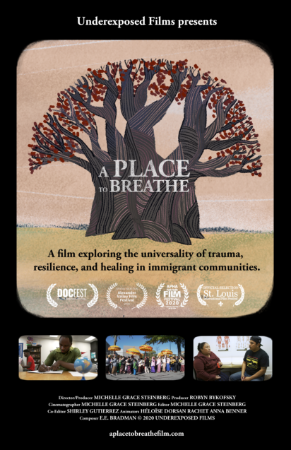
A Place to Breathe 2020
Distributed by Good Docs
Produced by Michelle Grace Steinberg and Robyn Bykofsky
Directed by Michelle Grace Steinberg
Streaming, 86 mins
High School - General Adult
Health Services; Human Rights; Immigration
Date Entered: 02/01/2021
Reviewed by Shanna Hollich, Interim Director of Library Services, Wilson CollegeA Place to Breathe primarily tells the stories of four families utilizing the services of two different immigrant and refugee health care centers in the U.S. Through a clever mix of real-time interviews, embedded reporting, and animated flashbacks, we bounce back and forth between the Metta Health Center in Lowell, Massachusetts, and the Street Level Health Project in Oakland, California. As the documentary unfolds, we get an intimate look into the histories and current lives of refugees from the Congo, Cambodia, and Guatemala; undocumented immigrants from Mexico and Uruguay; as well as the doctors, nurses, and aid workers who help them navigate their lives and their healthcare.
This film has many strengths. It has a narrative format that focuses solely on the subjects - indeed, the filmmakers are never shown on camera - and this allows the viewer to really feel as if they are getting to know the people portrayed here. The community members are all relatable, and we see them in a variety of humanizing situations - at the grocery store, at the health clinic, in their homes, talking to their loved ones, walking their dogs. Though the documentary does jump back and forth in both location and time, there are clear captions and signposts that ensure the viewer does not get lost, and the technique is effective in keeping the story flowing.
The film is ostensibly about integrative medicine and health equity, and it would be a great addition to a library collection or classroom setting looking for culturally aware materials in the health sciences. We hear doctors from the Metta Health Center discuss their desire to combine “Western medicine with cultural competency” as they incorporate modern medical technology with more traditional medical techniques such as acupuncture, cupping, and massage. Oakland’s Street Level Health Project is similarly focused on a “whole-person care model,” where the focus is not only on providing medical care in a multilingual and culturally-competent setting but also on providing mental health care and social services, including workshops and information about going to school, getting a job, interpreting federal regulations and executive orders, and offering legal advice.
Where A Place to Breathe shines brightest, however, is in its acknowledgement that health care does not occur in a vacuum, and neither do the stories of the people represented here. As one of the nurses says in the film, “It’s important that patients see us out of uniform,” and they (both the clinical staff and the filmmakers) take care to be present in the community and at all sorts of cultural events. At its heart, this type of clinical care work is about building relationships and building trust with the people in the community who are often the most underserved by the traditional healthcare establishment, and the film does an excellent job of highlighting this. There is a strong focus here on culturally responsive care, on hiring people from the same cultures as the community being served, and many of the patients we follow throughout the film talk about their own plans to give back to the community in various ways, whether it be through going to nursing school in order to come back and work in the clinic or to serve as a translator for patients and their families.
What this film does best is remind us - teachers, clinicians, students - that the people we interact with each day are whole people, with stories that run deeper than we can possibly know. While the film primarily focuses on the present day, each of the four main subjects is given time and space to tell the story of their life both before and after they came to the U.S. These stories, like many refugee stories, are filled with tales of war, violence, rape, and pain, but the filmmakers ingeniously employ animated sequences for these scenes. This allows for the viewer to maintain a certain amount of psycho-social distance, which can be helpful when reflecting on moments of deep trauma and allows the subjects to feel more comfortable telling their stories, knowing that their image and their facial expressions will not be the camera’s focus. Instead, we are able to visualize and process their stories through art, which serves to make a potentially fraught part of the film more poignant, and potentially more impactful.
This film is highly recommended and could be used across a variety of subject areas, including health sciences; sociology and social work; American studies; race, culture, and ethnic studies; global studies; and political science.
Awards:
Interfaith Documentary Award, 2020 St. Louis International Film Festival
Published and licensed under the Creative Commons Attribution 4.0 license. Anyone can use these reviews, so long as they comply with the terms of the license.